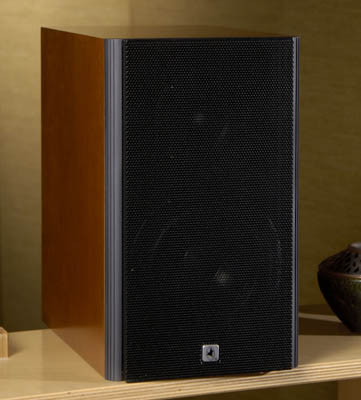

UPDATES:
May 22, 2008 - I've added a couple pictures of the back of the LCR here to show where the optional wall brackets can be mounted.
June 5, 2008 - Comments regarding BLS performance on stands has been added here.
November 20, 2009 - I've recently added a set of Outlaw Surround Loudspeakers to the system and have added a new section specifically discussing them when used in "diffuse" mode as side surround speakers.
It was my upgrade to a little-known Dolby Digital/DTS receiver called the Outlaw Audio Model 1050, back in 2000, that led me to purchasing my first really good speakers in the spring of 2001: a pair of Paradigm Reference Studio 60v2 towers, Studio CCv2 center, and three Studio ADPv2 surrounds. For over seven years, those speakers have served me very well indeed – I am still very fond of them. When we moved in early 2004, I was able to upgrade to a 7.1 setup but was forced to change the side surrounds to bracket-mounted bookshelf speakers due to space constraints, and the Axiom M3ti speakers that I have been using for that are simply not as capable as the Studio ADP's they replaced (the ADP's moved to back surrounds, with the third ADP getting sold to finance the M3ti's). At some point, though, my wife started inquiring about whether we could find bookshelf speakers that could do as good a job as the Studio 60 towers. Those inquiries were part of what led me to contemplate Outlaw's Bookshelf Loudspeakers (BLS), especially after the matching LCR Loudspeaker arrived in late 2007. (A bit of upgradeitis probably contributed as well, since the Paradigms were second only to the mid-1990's S-VHS VCR for age and time spent in the system.) It took a few months of debate, hand-wringing, setting aside money, and general indecisiveness to finally lead me to the point of placing an order for new front and center speakers. The result was a trio of finely-crafted speakers that have claimed the positions long held by my Paradigm Studio 60's and Studio CC. A list of all my associated equipment can be found here, at the end of this review.
We decided to pay a bit extra for the cherry finish on all three speakers, so I was interested in seeing how a speaker with a true veneer finish would look next to the rosenut and black laminate finishes on my Paradigms. The first step, though, was getting the boxes home from work and getting past the cardboard packaging to the actual speaker itself. The pair of boxes (one for the BLS's and one for the LCR) arrived in very good condition, and inside the double-layer of cardboard there was a healthy array of heavy foam securing the plastic-wrapped speakers. Small foam blocks filled the spaces between the fronts of the speakers and the upper and lower edges of the metal grilles.
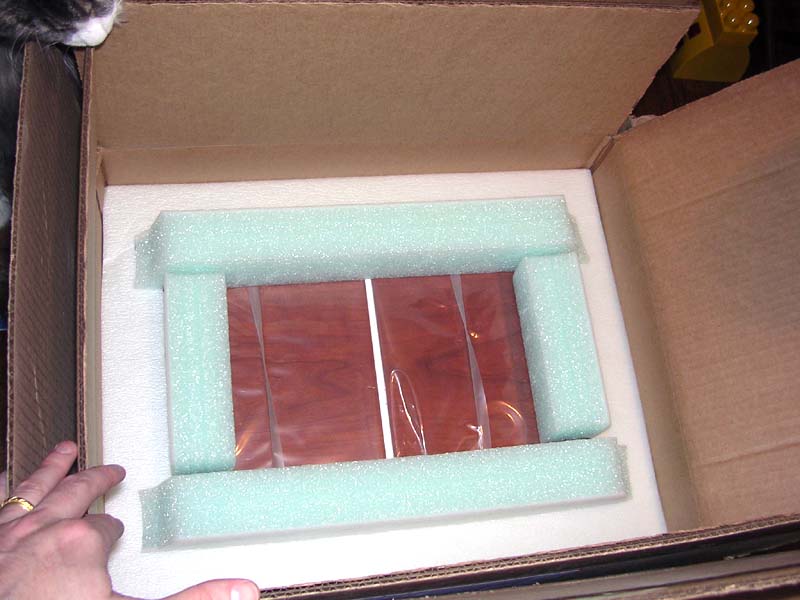
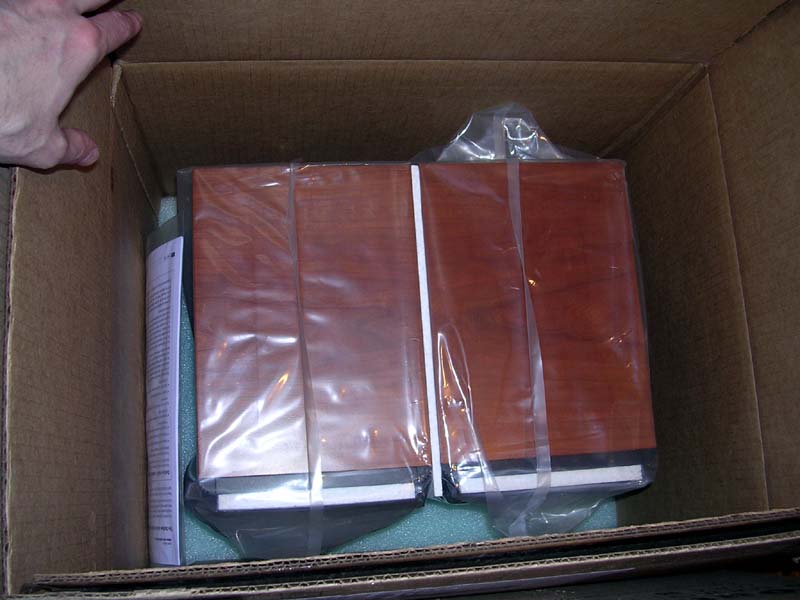
Unpacking the speakers
Once I had the speakers out of their boxes, I found myself focusing on three things. First, the finish. Instead of the painted black finish (which is reportedly very similar to the finish on my LFM-1), these have real cherry veneer over the MDF cabinets. The veneer work is extremely nice. My co-worker Chip and I spent several minutes just turning one of the BLS's over and over, looking at the finish and marveling at the quality. They are pretty, moreso than any of the pictures I've seen (or taken) of them really convey. The next thing I noticed was the rounded trim pieces on the front. Based on pictures, I'd initially taken these to be plastic (size and shape of grooves didn't seem suggestive of wood), but they are in fact metal – specifically aluminum, if I'm not mistaken. The trim that I'd thought might seem a little "cheap" based on the pictures is actually a very smooth and solid-looking detail, adding to the overall impression of good quality construction. This trim leads directly to the third feature that drew my attention: the grilles. I've been noticing metal grilles more and more lately, even though they're far from new. The method of connection for the Outlaw grilles had never been quite clear to me until I saw them. The grilles are flat across the front and bent 90° at the sides. About 3/8" back from that bend, the metal narrows slightly (stepping in at the top and bottom). Past that point, there's a solid metal "tab" about 3/8" long that's wrapped in vinyl-coated fabric. That fabric-wrapped tab slides into a groove between the aluminum trim and a pair of notches in the sides of the MDF front face of the speaker, with the fabric providing both a secure fit and a rattle-free contact between the three separate materials. It's a very slick solution. The BLS's both offer a snug fit, while the LCR (with a longer grille and thus more surface area) is downright tight. The grilles themselves are quite handsome, and (as best as I've been able to ascertain) acoustically transparent. Further proof? The three were set up before my wife arrived home and it was not more than a couple hours before she commented that she liked the look of the new speakers, with the grilles getting specific mention.
Not long before I ordered these, an AVS Forum member reported spotting a batch of drivers with Outlaw labels sitting in a Snell facility in Massachusetts. He even had a picture of the drivers and their "Outlaw" labels, with some Snell drivers in the frame as well. It has since been confirmed that the previously-unnamed US manufacturing facility responsible for building these speakers is Snell, a very well-regarded speaker manufacturer in their own right as well as the current home of well-known designer Dr. Joe D'Appolito (he's been their chief engineer since early 2003). Indications are that the Outlaw speakers are not recycled Snell designs, as there don't appear to be any Snell speakers with the exact array of controls offered by the BLS and LCR. Lips are still sealed about the specific details of how the designs were developed, though. Since I found the information to be of interest – even if we don't have all the details – I figured I'd mention it here. It also makes a nice point to wrap up my first impressions and start looking at the real nitty-gritty. After all, even the best lineage is only meaningful if the product delivers the goods when asked to stand on its own...
There's a fair bit to think about when setting up the BLS and LCR speakers. Like any speaker, you have to think about placement and toe-in. Even after that, though, there are more options to consider: boundary compensation, high frequency adjustment, and (for the LCR) center/main configuration. I started out with placement first, except for verifying that the controls were all set to "zero" and the LCR was set to operate as a center. My center goes on top of the TV cabinet, about a foot above the TV, with a small wedge under the back to provide some downward "toe-in." Eventually, the fronts are going to go on stands to bring the tweeters to the optimal height, but initially thet were set up on top of the side equipment cabinets with a very minimal toe-in. It's not ideal, but it's a start – and if they can get the job done up there, the stands that I plan to build later this year (and the test stands I plan to build this month to test the design I have in mind) will only make a good thing that much better.
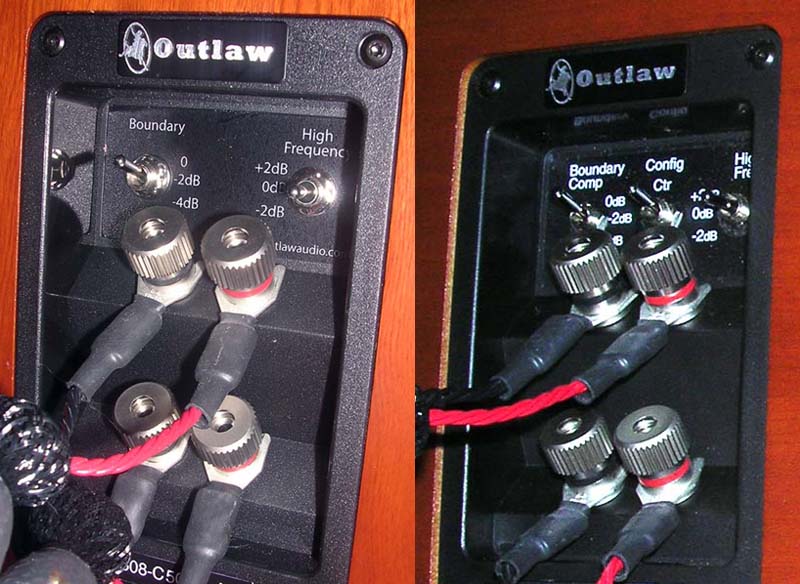
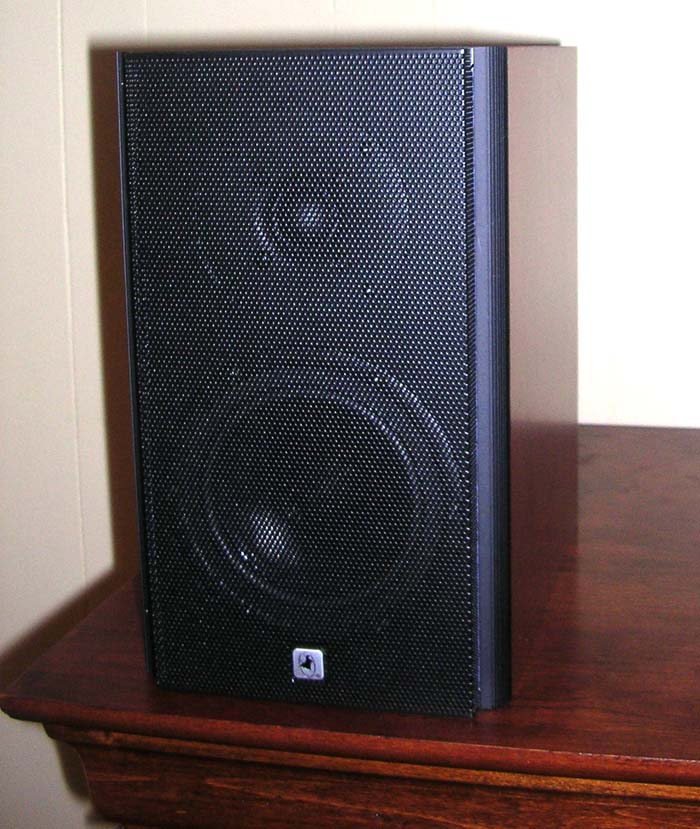
Because my LCR is serving as a center channel and is located above the TV in a horizontal orientation, I used the "Ctr" setting. For the other controls, I started out with both at "0dB" and did listening tests later to evaluate my options. Even though the boundary compensation setting that seemed best suited to my space was that "0dB" default, I planned to also test at least the "-2dB" setting. If that setting didn't pan out, I figured that I'd skip "-4dB" and just stick with the "0dB" default. For high frequency control addressed a more difficult issue to predict, unless you have a well acoustically treated space that is already optimized, so I decided to try both the "+2dB" and the "-2dB" settings. I'll leave my findings from these tests for the next section of the review.
Update 5/22/2008: I had a request for a picture of the of the back of the LCR, showing the anchor points intended for use with Outlaw's wall mounting brackets (available separately from Outlaw for $25 per speaker). As a result, I've added the two pictures seen above. Note that you can click on the first picture to see a higher-res version of the image.
My goal for the BLS/LCR team was simple: at least match the performance of my trusty Paradigms. If they sounded better, that was great, but the objective was to use a bookshelf speaker setup without sacrificing audio quality. I had thirty days to figure out if the upgrade to smaller, more wife-friendly speakers was an improvement, a lateral move, or a detriment. My first few days, before any calibration was done and while not making any effort to listen critically, gave me a sense that the Outlaw's sound was not only matching the Paradigms but even sounding a touch better.
Later that weekend, I tossed a few other things into the mix, starting with the Blu-ray of Dave Matthews and Tim Reynolds at Radio City Music Hall on Saturday afternoon and following up the next day with an assortment of discs. The Sunday assortment included a drum solo by Rush's Neil Peart ("The Rhythm Method" from A Show of Hands), during which I started to notice some subtle details that had never been as clear before – particularly in the faster sections, when individual strikes on the drums or the cymbals became more distinct than I ever remember hearing previously. Likewise, spending a little time with the DVD-Audio release of Toy Matinee (quirky little album from the early 1990's) revealed a great finesse with the details in that album.
All of this listening told me two things: I still wanted to work on some stands to bring the Bookshelves down closer to their optimal positions, and the Outlaw trio was a team that were able to both match my larger Paradigms point-for-point and even do a step better. There were still two things left to contemplate, though: the rear toggle switches, and stands. I came up with a stand design that I thought would be satisfactorily unobtrusive the first weekend that I had the speakers, but it took took another week to gather supplies and a further week or so after that to start building the stands. The toggle switches required a bit less prep work, so I dug into those first. The boundary compensation setting of "-2dB" was my first stop, and it took only a couple sampled songs to get a feeling of closed-in or veiled sound, so I tossed them back to "0dB." Several subsequent tries with the boundary compensation control yielded the same result. This wasn't terribly surprising, as my room layout was a perfect fit for the "0dB" boundary compensation condition described in the Outlaw manuals. The high frequency switch was one that I was more unsure about, so I started with the "+2dB" setting, switching back and forth between that and the "0dB" default setting a couple times. Again, I found myself preferring the default, this time because the "+2dB" setting was a bit too bright for my tastes. Of course, the amount of hardwood, brick, and glass in my room should have made it self-evident that the space was not over-dampened. I'd always felt that our efforts to soften the room had been reasonably effective, but it wasn't until I tried the high frequency setting of "-2dB" that I decided I wasn't entirely correct. The difference between a "0dB" and a "-2dB" setting on the high frequency control was subtle, but I felt comfortable deciding that I preferred "-2dB" after only a short listening session with the "-2dB" setting. In the end, I settled on "0dB" for boundary compensation, "-2dB" for high frequency, and "Ctr" for the LCR center channel. When and if I upgrade my side surrounds, I'll probably run them alone briefly to dial in the boundary compensation and high frequency settings, but I'll probably start with "-2dB" or "-4dB" for the boundary compensation (both are placed in more cramped quarters) and "-2dB" for high frequency.
Almost from the moment I set the Bookshelves up, I wanted to get them onto 30" stands so they were more optimally placed, but I had some concerns about stability (both because of our three-year-old and because of a certain rambunctious one-year-old Maine Coon kitten) and aesthetics (since these speakers were purchased in part to be more spouse-friendly than the old towers). A friend at work has offered to help build some stands out of nice wood, but we're too busy right now to have much time to do that yet. I had an idea for a stand design the first weekend that we had the speakers, and I decided to build a "test" set of stands based on that design as a temporary measure. It would let me evaluate the stability of the design and it would get the speakers on stands sooner. Unfortunately, even those test stands are taking some time to get done, so I don't expect to have them in the den for another week or two. Once the stands are in place and I've had some time with the speakers at their recommended height, I'll update this review with my findings.
Update 6/5/2008: It took me several weeks to find time to finish the stands (such as it were – their final form re-confirmed my intent to pursue getting some better-made stands at a later date) and get them into the den. These stands were sort of an experiment, testing an idea for a stand design that I figured could be recreated in nicer material or finished better later. Finally, over the Memorial Day weekend, I got the stands in the house and pulled the speakers down onto them.
As soon as I had the Bookshelves down on the stands, I fired the system up for some initial listening. The effects were readily apparent as a widening of the soundstage and improved imaging. Some of the soundstage improvement is likely due to the speakers being spread out a bit more, but I really think the imaging is due to the speakers being at the listener's level now. It is very pronounced when listening to music, but it is also beneficial with movies and TV. When I was settling in to write these notes down, I was startled to note how clear and wide the soundstage was on a TV show (hardly the greatest source material) when I wasn't even paying attention to it. Even though I'm not terribly impressed with my workmanship on the stands, I will definitely be leaving the Bookshelves on them until I can find something better to use as supports for them. They deserve to be at their optimal mounting height.
Added 11/20/2009: Earlier this fall, Outlaw announced a new addition to their speaker line: the Surround Loudspeaker, or SL. Shortly after the announcement, I ordered a pair for my side surrounds to replace some Axiom M3ti's. The M3ti's were installed after we moved in January 2004 due to space restrictions that prevented me from using my Paradigm Studio ADP's. The M3ti's did a fair job, but they were never the equal of the other speakers in the system. They also were not dipole surrounds. I'd been contemplating some BLS's as replacements, but the SL's provided me with a better alternative.
My original expectations for the first Transformers movie were very, very low, and I rented it from Netflix simply out of curiosity. As such, I really was pleasantly surprised to get a somewhat silly, slightly over-long, generally fun summer action movie. That wasn't enough to cause me to actually try to see the sequel in theaters, though, so this was my first viewing of Transformers 2. The soundtrack was as lively and theater-testing as one would expect, and several times I found myself noticing that the surround effects were more open and non-localized (for lack of a better term) with the SL's. Never did I find myself thinking, "there is the speaker" and being able to pinpoint either of the surrounds. They did the job of creating an enveloping mix admirably. In that regard, they were a definite upgrade. The Dark Knight (the only movie of 2008 that I actually succeeded in seeing in theaters while encumbered by my broken hip) just reinforced that assessment. They did a great job handling the back of the room. The inactive rear surrounds really weren't missed.
On Tuesday, I lost almost half of the day to a conference call for work, but I was still at home. That gave me a chance to try out the new Up Blu-ray. This allowed me to get some idea of the effectiveness of the SL's at blending with the Outlaw speakers that provide the front trio (BLS fronts and LCR in the center). Little things like the knocks on Carl's front door were stretched into the right surround, and they were so well voiced that twice I wondered why someone was knocking on my deck door.
With the arrival of the SL's, I finally have side surrounds that are the equal of the other speakers in the room. At some point, I will replace my Paradigm ADP's with a second pair of SL's that I will most likely operate in "direct" mode as rear surrounds.
I initially was reluctant to upgrade my front speakers, as the Paradigm Studios are still very good speakers. Eventually, I decided to give the Outlaw speakers a try, see how they compared to my familiar old Paradigms. There was some uncertainty involved in this process, as the Paradigms were both good speakers and much larger speakers (particular the Studio 60 towers). Happily, it took very little time to convince me that my reluctance was unfounded. The Bookshelves and their LCR sibling have been a rousing success for both me and my wife. I am contemplating the idea of looking into a set of black B-stock Bookshelves for side surround duty, as a replacement for my Axiom M3ti's, but at this point it is mostly a matter of collecting the funds and waiting on B-stock availability (feel bad about the very idea of drillig holes in A-stock to mount them in my side surround positions). Hopefully before 2008 comes to an end, I'll have switched to a pair of Outlaw Bookshelves for my side surrounds.
Even without delving into the world of ultra-high dollar speakers, there are a lot of good speakers available today. I dare say there are more than a few really great speakers, for that matter, and we could devote a whole paragraph just to naming some of the well-regarded companies that have been building high quality speakers for years and even decades. More recently, the internet direct business model has been well suited to the speaker and subwoofer business, perhaps even moreso than to the electronics business. Outlaw is a bit unusual in this regard, as they started out with internet-direct electronics (still a somewhat rare approach) before eventually adding subwoofers and only recently trying their hand at speakers. At $1,000/pair ($1,100 in the cherry finish) for the Bookshelves and $650 each ($700 in the cherry) for the LCR, Outlaw's speakers are competing in a market that includes no shortage of great offerings, so trying to carve out a presence there is no modest undertaking. It may come as no surprise, then, that in spite of their relatively small size these Outlaws are no modest speakers, either. With a construction and appearance that satisfies the spouse and the sound quality that I demanded, I expect these to remain in the system for many years to come.
SOUND:
I started my "serious" listening with the Bookshelves still on top of the cabinets, without having tracked down temporary speaker stands for them. I re-calibrated the Model 990 around 10:15 one Friday night, and around 10:30 I decided to try a CD or two out. An hour later, I finally stopped to jot down some notes and go to bed. Each disc or song would make me think about something else to try, and it was only the pursuit of more listening material that could get me out of the listening position. I tried a fairly eclectic mix of stuff that first night – Tantric's first album, a little Vanessa Carlton, a Stone Sour track that we'd been talking about at work earlier that day, some Alison Krauss, and a little Star Wars soundtrack stuff. The Vanessa Carlton disc includes a live version of "Twilight" that consists solely of her on the piano. It's a recording that I've always been fond of, and with the Outlaws there were details that came through more clearly than I was used to. In particular, there were times when it seemed that I could almost feel the pressure applied by the piano's pedals. Great detail and clarity, and very non-fatiguing. I think the best measure of the speakers, though, was the way they seemed to draw me in with their sound, such that I didn't want to stop listening.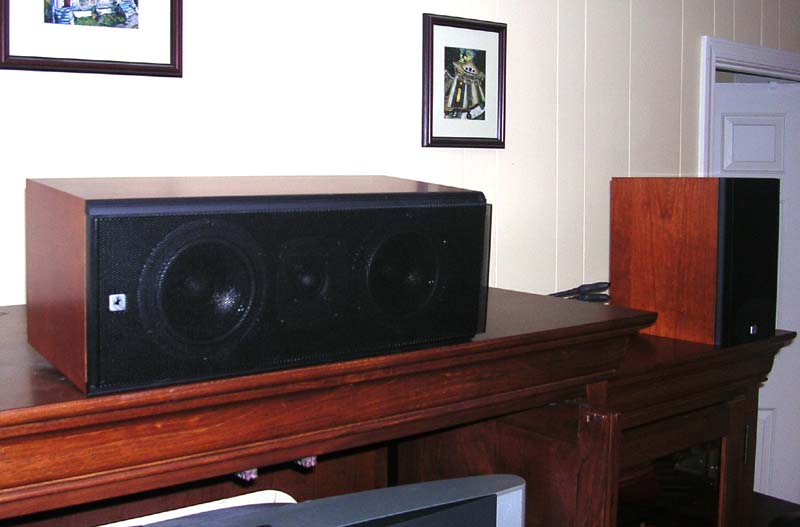
LCR and right Bookshelf
SURROUND LOUDSPEAKERS:
My SL's are mounted in the only available locations on my side walls. They are not exactly optimal positions, but with the wall brackets I had from the M3's they have a reasonable chance of doing the job. They are smaller than the M3's in depth and height, although the sloped sides result in a wider face. The metal grilles give them what I consider to be a more handsome appearance, as well, and the aluminum top and bottom plates are a really nice aesthetic touch that I hadn't expected. I've had them installed for several weeks now, but our busy schedules had limited opportunities to really crank the system up and listen loud. Without that true test, my initial feelings were very positive, though. The surrounds seemed more natural and integrated when watching 5.1 sources, which is likely a combination of the dipole design (mine are set for "diffuse" operation rather than "direct") and the performance of the speakers themselves.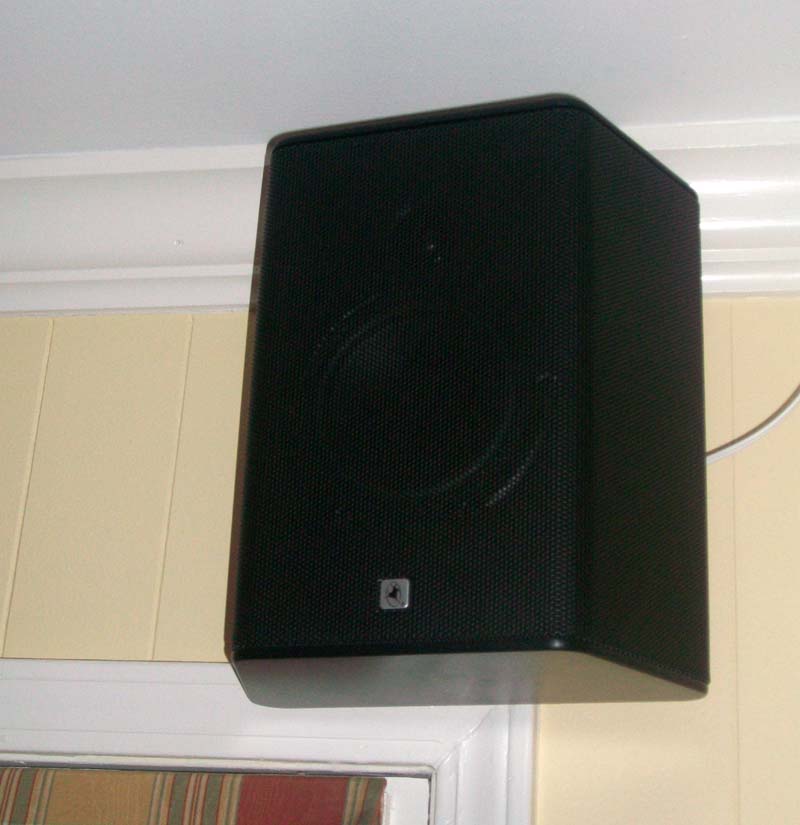
Right Surround
Then last week I had some work done on my right hip. The three large screws that were installed in May 2008 came out, and some other work was done to the head of my femur in hopes of slowing or halting the signs of necrosis likely caused by my fall last year. I was left to sit at home for a few days, and on Monday (the first day that I really had the place to myself) I queued up two Blu-rays to give the system a good workout: Transformers 2 and The Dark Knight. I had my BDP-83 set to bitstream over HDMI (a setting that fluctuates from time to time and is actually set to LPCM more often than not), and my Onkyo 885 defaulted to straight decoding of the lossless 5.1 tracks from both discs. I decided not to overlay Pro Logic IIx (which is my usual choice) in order to evaluate just the 5.1 performance without any additional contribution from the Studio ADP back surrounds.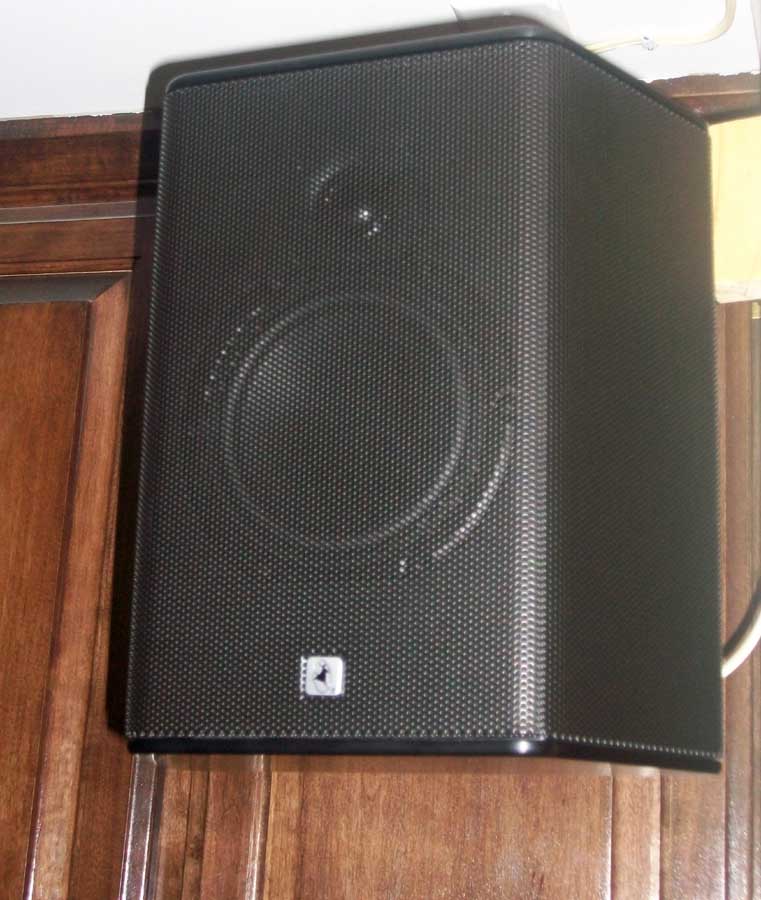
Left Surround
CLOSING THOUGHTS:
EQUIPMENT LIST:
If you have any questions about this review, click here and I'll get back to you as quickly as I can.
(see also OPPO Digital DV-980H, OPPO Digital DV-981HD, OPPO Digital OPDV971H, Yamaha DVD-S1500, and Panasonic DVD-RA60)